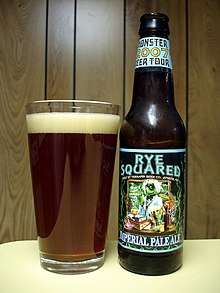Rye beer
Rye beer refers to any beer in which rye (generally malted) is substituted for some portion of the barley. Rye beers are considered specialty beers that are brewed with unusual fermentables such as rice, corn, or wheat.[1]

One example of this is roggenbier which is a specialty beer produced with up to sixty percent rye malt. The style originated in Bavaria, in southern Germany, and is brewed with the same type of yeast as a German hefeweizen, resulting in a similar light, dry, spicy taste.
In the United States, another style of rye beer is being developed by homebrewers and microbreweries. In some examples, the hop presence is pushed to the point where they resemble American India pale ales (IPAs).[2] This style is often called a Rye IPA, or just a "Rye-P-A", a take-off of the abbreviation for an India Pale Ale: "IPA."
Finnish sahti is another style of rye beer, produced by brewing rye with juniper berries and wild yeast.
Another type of rye beer is the traditional Slavic kvass, although the alcohol is low enough to be considered a non-alcoholic beer in many cases; it is made using bread that has been steeped and fermented.[3]
Roggenbier
Until the 15th century, it was common in Germany, particularly in Bavaria, to use rye malt for brewing beer. However, after a period of bad harvests, it was ruled that rye would be used only for baking bread, thus only barley was to be used for beer; see the German law known as the Reinheitsgebot. Roggenbier disappeared for almost five hundred years.
In the late 1980s the Spezialbrauerei Schierling near Regensburg created the first modern Roggenbier, Schierlinger Roggen, using a modified, patented mashing regime to cope with the effects of the highly viscous rye wort.[4]
The modern version of Roggenbier is typically about 5% ABV and is fairly dark in colour. The flavour is grainy, often having a hearty flavour similar to pumpernickel bread. Typically, at least 50 percent of the malts used to make the beer are made from rye.[5]
To date very few German breweries produce Roggenbier.
References
- "Hybrid Beer Style Guide - Hybrid Beers | Beer of the Month Club". The Microbrewed Beer of the Month Club. Retrieved 2018-10-03.
- "Full Moon Pale Rye Ale | Real Ale Brewing Company". BeerAdvocate. Retrieved 2018-09-07.
- "Dogfish Head Craft Brewery - Zwaanendale". www.beermonthclub.com. Retrieved 2018-10-03.
- "Beer with rye-aroma and process for manufacturing the same". patents.google.com. Retrieved 2019-06-27.
- "Deutsche Brauer-Bund". Archived from the original on 2001-11-22. Cite journal requires
|journal=(help)